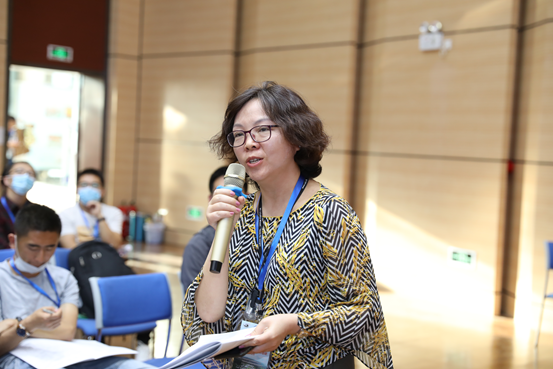Yin Wen is a senior researcher at the Institute of High Energy Physics (IHEP) of the Chinese Academy of Sciences. In 2005, she joined the China Spallation Neutron Source (CSNS) project at IHEP and assumed the responsibility of physical design of the shielding system for CSNS’s target station and its instruments. Now she is the deputy director of the Neutron Science Department at CSNS, and is also the Principal Investigator (PI) of the Multi-Physics Instrument (MPI), the first neutron total scattering diffractometer in China. On Jan. 26, 2020, MPI received the neutron beam from the target station, marking the instrument’s successful completion after two years of construction.
A “Lamei” from Chongqing
Dr. Yin was born in November 1972, in Chongqing, a mega city in the western part of China. In 1989, Dr. Yin graduated from the Forty-ninth Middle School of Chongqing City. In 1993, she got her bachelor’s degree from North University of China (NUC). In July 1996, after receiving a master's degree in metal materials from NUC, she joined the Department of Physics, Shanxi University as a lecturer.
Chongqing is the most important city in western China and is its economic engine. Speaking of Chongqing, people always think of its spicy food and signature spicy hotpot, as well as the Chongqing “Lamei”, a nickname for females who are brave and straightforward from this part of China. The city’s unique geography and culture may be one reason to form Dr. Yin’s strong personality, but she did work hard and never give up on her dream of being an outstanding female scientist.

Dr. Yin sitting along the Yangtze River in Chongqing
Dr. Yin undertook doctoral study while working at the university and obtained her Ph.D. from Shanxi University in 2004. Following her dream of being a scientist, in 2005, Dr. Yin made a career change and decided to move to Dongguan, a rapidly growing city in China’s Greater Bay Area, to join the CSNS project.
Located at Dalang of Dongguan City, CSNS is the fourth pulsed neutron source in the world and the largest scientific infrastructure project in China at that time. Dr. Yin’s job was to design the shielding system for the target station and its instruments. This part of work is highly crucial, because it secures everybody’s safety when the big machine runs.
She is keen to the activities in the international community of neutron science. In 2007 and 2012, she went to the United States, as a visiting researcher at the Oak Ridge National Laboratory. There she learned from the American colleagues, about how the shielding system works at the world’s most powerful pulsed neutron source and how an instrument was built from scratch.
Research Interests
One of Dr. Yin’s main research interests is the design of neutron physics for particle transport processes at CSNS. She contributed to the shielding and radiation protection design of the target station, as well as calculation of the radiation damage and life assessment of the core components of the target station. She also proposed the design for a large volume coupled para-hydrogen moderator, which resulted in a 30% increase in the neutron flux with wavelengths over 4 angstroms.

Yin speaking at a national academic conference
Dr. Yin is also interested in the mechanism of interaction between helium atoms in metals and in radiation point defects under the action of high-energy particles. One of her recent research studies explored helium behavior in bilayers of different materials. The results of her experiment conducted in the Multi-purpose Reflectometer showed that helium atoms formed a helium enrichment layer at the interface due to potential misalignment. This suggests a new idea for the selection of anti-radiation materials for spallation sources and fusion neutron sources.
A New Role: Working as an instrument scientist
The coronavirus outbreak didn’t stop Dr. Yin’s team from building the Multi-Physics Instrument (MPI), the first user instrument at CSNS. On Jan. 26, 2020, MPI received the neutron beam from the target station, marking the instrument’s successful completion after two years of construction. MPI was built in cooperation with Dongguan University of Technology and the City University of Hong Kong. It is also the first neutron total scattering instrument in China.
MPI’s success comes against the backdrop of the pandemic, which created a difficult situation for Yin and her colleagues, especially when they couldn’t proceed with production and installation of key components during the lockdown. Nevertheless, they managed to overcome these difficulties and successfully developed China’s first 12-cubic-meter neutron scattering vacuum chamber. What’s more, they also managed to install the neutron guide, even though they were unable to get any onsite help from the manufacturers due to the COVID-19 pandemic.
MPI will greatly propel research on materials with different ordered structures, especially the structural analysis of long-range order with locally disordered materials, and medium-range ordered and short-range ordered materials. The next goal for Yin and her team, is to cultivate users for this newly built instrument and develop it into a cutting-edge tool for probing the micro world inside materials.
On Mar. 8, 2021, Dr. Yin was awarded the 2020 National Woman Pace-setter. She is one of the ten women in Guangdong Province winning this award.



